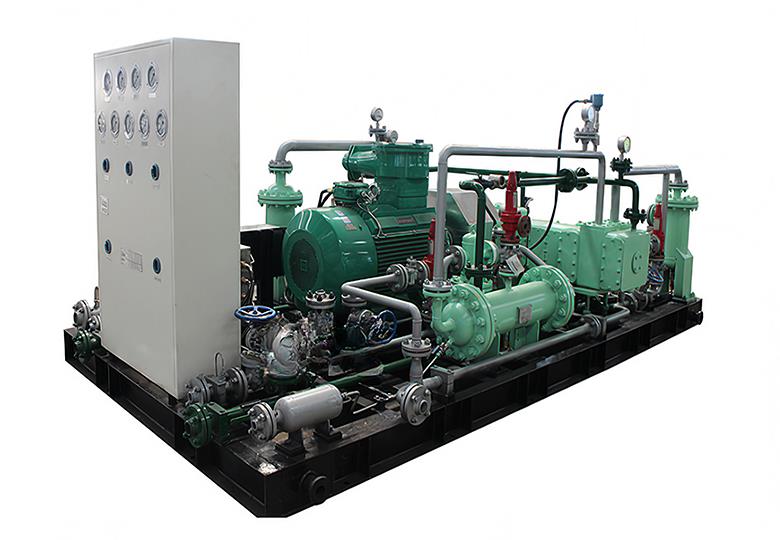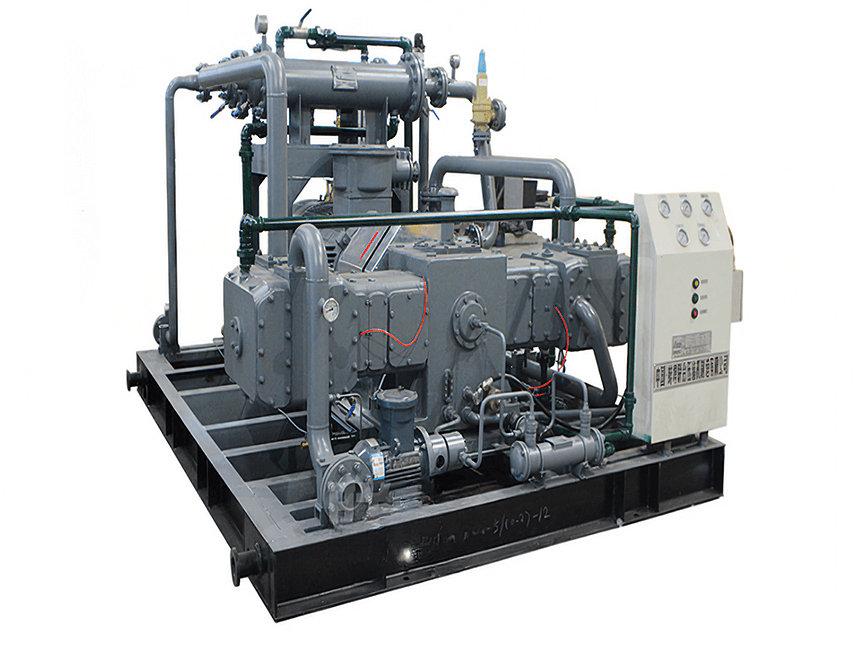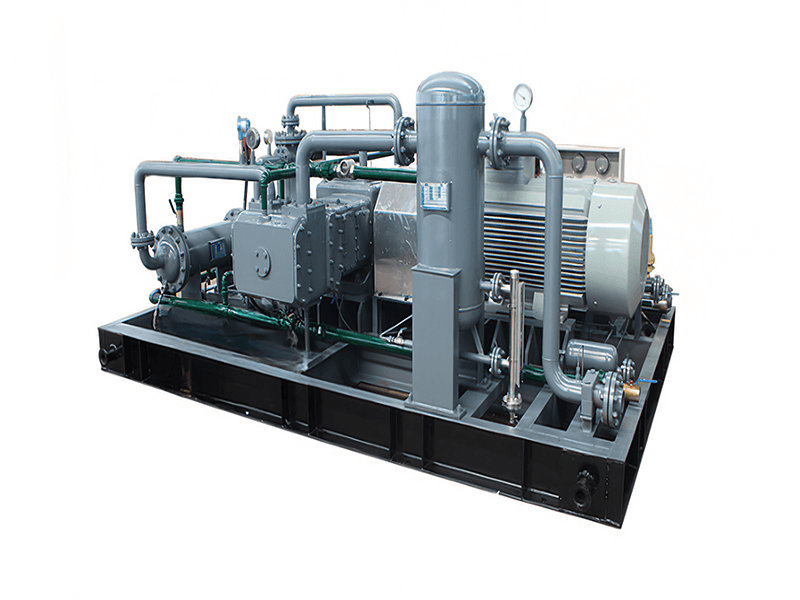A hydrogen compressor typically consists of several key components that work together to compress hydrogen gas. Here are the main components commonly found in a hydrogen compressor:
1. Compressor Housing: The compressor housing encloses and protects the internal components of the compressor. It provides structural integrity and often includes inlet and outlet ports for the flow of hydrogen gas.
2. Inlet and Outlet Ports: These ports serve as entry and exit points for the hydrogen gas. The inlet port allows the hydrogen gas to enter the compressor, while the outlet port releases the compressed hydrogen gas.
3. Compression Chamber: The compression chamber is where the actual compression of hydrogen gas takes place. It contains the compression mechanism and is designed to withstand high pressures. The compression chamber may include valves or seals to control the flow of hydrogen gas during the compression process.
4. Compression Mechanism: The compression mechanism is responsible for reducing the volume of hydrogen gas and increasing its pressure. Different types of compression mechanisms can be used, such as piston, diaphragm, screw, or centrifugal compressors, depending on the specific application and pressure requirements.
5. Electric Motor or Engine: The compressor is typically driven by an electric motor or an engine. The motor or engine provides the mechanical power needed to drive the compression mechanism and enable the compression process.
6. Cooling System: Compressing hydrogen gas generates heat, and a cooling system is essential to manage the temperature rise. The cooling system can include components such as intercoolers, heat exchangers, or water jackets that help remove heat from the compressed gas or the compression mechanism.
7. Pressure Control and Safety Devices: Hydrogen compression systems incorporate pressure control and safety devices to ensure safe and reliable operation. These devices can include pressure relief valves, pressure switches, pressure gauges, and safety interlocks that monitor and regulate the pressure within the compressor and protect it from overpressure conditions.
8. Lubrication and Sealing Systems: Compressors require lubrication and sealing systems to minimize friction, maintain proper operation, and prevent leaks. Lubrication systems deliver lubricating oil to the moving parts of the compression mechanism, while sealing systems ensure that hydrogen gas does not escape from the compression chamber.
9. Control and Monitoring Systems: Modern hydrogen compressors often feature control and monitoring systems that allow for precise control of compression parameters and provide real-time monitoring of pressure, temperature, flow rate, and other operating conditions. These systems enhance the efficiency, reliability, and safety of the compression process.
These are the fundamental components typically found in a hydrogen compressor. The specific design and configuration of a hydrogen compressor may vary depending on the application, required pressure range, capacity, and other factors.
Maintenance of a hydrogen compressor
Proper maintenance of a hydrogen compressor is essential to ensure its reliable and efficient operation. Regular maintenance helps prevent breakdowns, extends the lifespan of the compressor, and ensures the safety and performance of the hydrogen compression system. Here are some important maintenance tasks for a hydrogen compressor:
1. Inspection and Cleaning: Regularly inspect the compressor for any signs of wear, damage, or leakage. Clean the compressor and its components to remove dirt, debris, and contaminants that can affect its performance.
2. Lubrication: Follow the manufacturer's guidelines for lubricating the compressor. Lubricate the moving parts of the compression mechanism, such as pistons, bearings, or gears, using the appropriate lubricating oil or grease. Check and replace the lubricant as needed.
3. Filter Replacement: Inspect and replace the filters in the compressor's intake system. Filters help remove impurities and contaminants from the incoming hydrogen gas, protecting the compressor from damage. Clogged or dirty filters can restrict the gas flow and reduce the compressor's efficiency.
4. Cooling System Maintenance: If the compressor has a cooling system, ensure that it is functioning properly. Clean or replace any cooling fins or heat exchangers to maintain optimal cooling efficiency. Check coolant levels and ensure proper circulation.
5. Pressure Relief Valve Testing: Test and verify the functionality of the pressure relief valve(s) regularly. Pressure relief valves are critical safety devices that protect the compressor from overpressure conditions. Ensure they are operating correctly and set at the appropriate pressure levels.
6. Tightening and Alignment: Periodically check and tighten the bolts, screws, and fittings of the compressor to ensure they are secure. Verify the alignment of the compressor components to avoid excessive vibration or misalignment that can lead to premature wear or damage.
7. Instrument Calibration: If the compressor has pressure gauges, temperature sensors, or other monitoring instruments, calibrate and verify their accuracy regularly. Accurate readings are crucial for monitoring and controlling the compressor's operation effectively.
8. Recordkeeping: Keep a maintenance log or record of all maintenance activities performed on the hydrogen compressor. This log should include dates of maintenance, tasks performed, any repairs or replacements made, and any abnormal observations or issues encountered. This record can help track the maintenance history and provide valuable information for future maintenance and troubleshooting.
9. Manufacturer Recommendations: Always follow the manufacturer's recommendations and guidelines for maintenance, including recommended service intervals and specific maintenance procedures. Manufacturers often provide detailed maintenance instructions and schedules specific to their compressor models.
10. Training and Qualified Personnel: Ensure that maintenance tasks are performed by trained and qualified personnel familiar with hydrogen compressor systems. Hydrogen is a highly flammable gas, and proper safety precautions should always be followed during maintenance activities.
11. Vibration Analysis: Regularly monitor and analyze the vibration levels of the compressor. Excessive vibration can indicate misalignment, loose components, or other mechanical issues. Address any abnormal vibration to prevent further damage and optimize the compressor's performance.
12. Leak Detection: Hydrogen compressors must be inspected for any potential leaks. Conduct regular leak detection tests using appropriate methods such as ultrasonic testing or hydrogen leak detectors. Address any leaks promptly to ensure safety and prevent loss of hydrogen.
13. Valve Maintenance: If the compressor utilizes valves, ensure they are inspected and maintained regularly. Check valve seats, seals, and springs for wear or damage. Clean or replace valves as necessary to maintain proper sealing and prevent gas leakage.
14. Electrical System Inspection: If the compressor is powered by an electric motor, inspect the electrical system regularly. Check the motor's connections, wiring, and insulation for any signs of wear or damage. Ensure proper grounding and adherence to electrical safety standards.
15. Alignment and Balancing: Periodically check the alignment of the compressor's components, such as the motor, coupling, and compression mechanism. Misalignment can lead to increased wear, decreased efficiency, and potential damage. If necessary, realign or balance the components to optimize performance.
16. Training and Safety Measures: Ensure that maintenance personnel receive proper training on the safe handling and maintenance procedures for hydrogen compressors. Familiarize them with the potential hazards associated with hydrogen gas and provide necessary personal protective equipment (PPE) for their safety.
17. Spare Parts Inventory: Maintain an inventory of critical spare parts, such as seals, gaskets, valves, and filters, to minimize downtime in case of component failures. Regularly review and update the spare parts inventory based on usage and manufacturer recommendations.
18. Performance Monitoring: Monitor the performance parameters of the compressor, such as pressure, temperature, flow rate, and power consumption, during operation. Establish baseline performance data and compare it to current readings to identify any deviations or potential issues. Address any performance anomalies promptly to prevent further problems.
19. Scheduled Overhauls: Plan and schedule periodic overhauls or major maintenance activities based on the manufacturer's recommendations, operating hours, or other factors. Overhauls may involve replacing worn components, refurbishing or upgrading parts, and conducting comprehensive inspections to ensure the compressor's continued reliability and efficiency.
20. Documentation and Reporting: Maintain detailed records of all maintenance activities, including inspections, repairs, replacements, and performance data. These records serve as a valuable reference for future maintenance, troubleshooting, and compliance with regulatory requirements.
By implementing these maintenance practices, the reliability, safety, and efficiency of hydrogen compressors can be maximized, ensuring uninterrupted operation and optimal performance. Regular maintenance is vital for preserving the integrity of the compressor and supporting the broader utilization of hydrogen as a clean energy resource.
More details regarding hydrogen compression
1. Compression Ratios: Hydrogen compression typically involves increasing the pressure of hydrogen gas from its initial or ambient pressure to a higher level. The compression ratio is the ratio of the final compressed pressure to the initial pressure. Higher compression ratios require more energy and can pose technical challenges due to factors such as gas leakage, heat generation, and material strength limitations.
2. Compression Technologies: Several compression technologies can be utilized for hydrogen compression, including reciprocating compressors, centrifugal compressors, screw compressors, and piston compressors. The selection of the appropriate compression technology depends on factors such as the required pressure range, flow rate, efficiency, reliability, and specific hydrogen characteristics.
3. Compression Efficiency: The efficiency of hydrogen compression is an important consideration as it directly impacts the energy consumption and overall economics of the process. The compression process can generate heat, and it's crucial to manage the heat generated during compression to prevent overheating and energy loss. Cooling systems, such as intercoolers or water jackets, can be employed to maintain optimal operating temperatures and improve efficiency.
4. Safety Considerations: Hydrogen compression requires careful attention to safety considerations. Hydrogen is a highly flammable gas, and compression increases its energy density, making safety measures critical. Equipment must be designed and operated to prevent leaks, minimize ignition sources, and incorporate safety features such as pressure relief valves, flame arrestors, and hydrogen gas detection systems.
5. Compression Infrastructure: To support the widespread use of hydrogen as an energy carrier, a well-developed hydrogen compression infrastructure is necessary. This includes the construction of hydrogen compression stations for refueling hydrogen vehicles, storage facilities for compressed hydrogen, and pipelines for transporting hydrogen over long distances.
6. Compression Standards: Standardization plays a vital role in hydrogen compression. Various national and international standards exist to guide the design, operation, and safety aspects of hydrogen compression systems. These standards ensure consistency, interoperability, and compliance with regulations, enhancing the overall safety and reliability of hydrogen compression operations.
Hydrogen compression is a critical aspect of utilizing hydrogen as an energy carrier and for various industrial applications. Continued advancements in compression technologies, along with the development of a robust hydrogen infrastructure, are essential to support the growth of hydrogen-based technologies and the transition to a low-carbon economy.


























